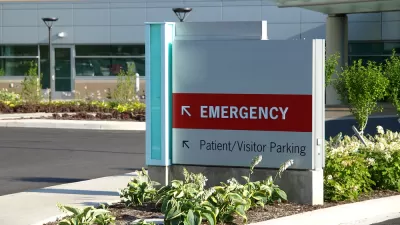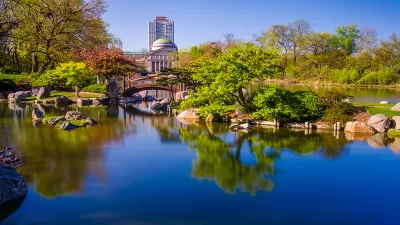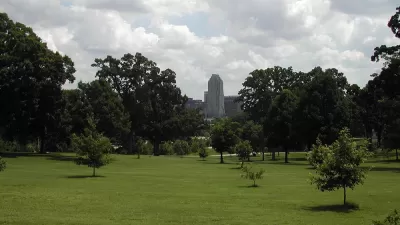Chicago has recently opened some of the most exciting urban landscapes we have seen in a while. And, as with New York and other cities, landscape architects are leading the charge.

Chicago has always seemed to me to be one of those great cities that everyone would want to live in if only the winters there weren't quite so brutal—like Boston, or maybe Minneapolis. I have been there in all four seasons and, it seems fair to say, summer is the best time to go. It's not just the warmth—which is a big deal in itself—but it is the crazy energy emanating from all of those people ecstatic to be outside after being pent up for so long that makes it special. Whereas people in the South tend to spend their summer cowered indoors, avoiding the melting heat and waiting for fall, those in Chicago can't seem to get enough of it.

I recently spent some time there and was able to see the city in all its summer glory. While people by the thousands were packing into mainstay places like Millennium Park, Lakeshore Trail, and Navy Pier, three new, high profile landscapes were also attracting crowds. While Chicago's parks and open spaces have been living in the shadow of those in New York City over the past several years, things are now changing. As if it had been biding its time for the right moment, the city is celebrating the latest in the dramatic transformation of its public realm. People in Chicago are understandably basking in all of the attention, and landscape architects deserve a lot of the credit.

Chicago Riverwalk
Trying to draw people to the edge of the very urban Chicago River that snakes through downtown has been an ongoing process. Projects previously completed over the past 15 or so years present a mixed bag of spaces that successfully add some nice green open space, but largely fail to provide the type of dynamic place that such a high-impact location deserves.
Thankfully, the work that opened this summer, which represents the first three of what will ultimately be six spaces designed by a team led by Sasaki Associates and Ross Barney Architects, is really great. The landscapes are wonderful in their conceptualization, design, and, perhaps most impressively, detailing. With solid design and impressive craftsmanship, the spaces are as beautiful as they are beautifully built.

Each open space is defined by the architecture of the intricate steel bridges that span the river and delineate city blocks. This separation allows for each landscape to be unique in character and respond to site-specific program uses. As both an aggregated composite and as individual spaces, the work exemplifies the remarkable ability the urban realm has to make theater out of everyday life. On warm days and evenings, these new landscapes burst with life, and—as great urban places typically do—equally satisfy the introvert and the extrovert in a crowded procession of people watching.

Of the three areas, the massive set of steps that maneuver the grade between Wacker Drive and the water's edge is the highlight—if not for practical use, then at least in terms of sheer drama. The steps span the entire block, with a steepness that seems to defy any sort of prescriptive code. Universal accessibility is designed into the space with a zigzagging ramp that defines its geometry while also providing its function. Large bald cypress trees dot the steps and add touches of softness to what is otherwise a very hard edge. Cleverly designed tree wells disguise what I imagine is complex infrastructure set up to ensure the health of the trees, understanding that replacing them would be a complicated endeavor moving forward.

The space is sleek and elegant, but it is marred a little by the addition of clunky railings that look more like crowd control barriers than the carefully designed elements found everywhere else on site. The added safety was obviously pushed by someone, and is somewhat understandable…but still unfortunate. The problem (and I admit it is a small one in the scheme of things) is not just the way they look. The presence of the railings jutting awkwardly into the space also fights against the simple concept that the trees are the only fixed vertical elements within the steps. My guess is that the design team would prefer to not have them there, too, as they read like afterthoughts. Even so, the overall effect of the space is pretty spectacular.
The other two spaces face less of a vertical challenge, since buildings take up much of the grade change. These buildings house restaurants and bars that enable people to flow out into the landscape and activate the spaces in warmer months. The design is a lot about accommodating a wide variety of uses and employs plenty of both fixed and movable seating. Benches, walls and steps beautifully transition the space from building face to the water’s edge. There is a lot going on, but it is all cleanly organized in a logical manner, so does not feel chaotic.

The area between State and Dearborn Streets is my favorite of the two from a design perspective. It is anchored by what seems to be an extremely popular (and overpriced) wine bar, with the space bisected by custom high-back benches that add a unique spot for seating while also providing a grade separation between the pedestrian thoroughfare on the low side, and the bar patrons above. As with the steps, the detailing here is exquisite.
Although each of the three areas has its own character, a consistency in materiality ties everything together nicely. This includes the paving, as well as a series of strip lighting embedded into various site elements—a far better solution than adding pole lights in the already tight spaces. The lights add a nice ambiance in the evening hours, but are a bit distracting after dark, when they shine a little too brightly.

All in all, the new portions of the Riverwalk are extremely well done and an obvious boon for downtown Chicago. The path of travel may get a little cumbersome in places—as runners and pedestrians sometimes seem to find it hard to coexist (and bikes don't even seem to be an option)—but the design team deserves a lot of credit for successfully maximizing the function of the spaces given the considerable constraints of the site.
With the first three spaces as good as this, I can't wait to see the rest.
Also…
- As I wrote about in a previous post, the Chicago design community was dealt a major blow with the recent and tragic death of the landscape architect Peter Lindsay Schaudt, who was a partner in the firm Hoerr Schaudt. He had done a lot of great work in the Chicago area—including the beautiful landscape around Solider Field, the restoration of the historic quadrangles at the University of Chicago and downtown’s Daley Center Plaza—and will be greatly missed. The good news is that Doug Hoerr will continue to do great work at Hoerr Schaudt. Doug is one of the best pure designers in the business and will undoubtedly keep the firm producing beautiful places long into the future.

- If you appreciate urban landscapes and have never been to the University of Chicago campus, you need to go. It is as beautiful as any park or garden in the area and should not be missed. For those who appreciate good architecture: the new Logan Arts Center, designed by Tod Williams and Billie Tsien, is, in my opinion, one of the best university buildings built over the past decade. It is stunning as it peers above the trees lining the Midway Plaisance. Hargreaves Associates designed the crisp landscape that lives up to the design quality of the building.
- I can’t think of any other mid-century modern landscape that I enjoy being in more than the Dan Kiley designed garden at the Art Institute of Chicago. It is the quintessential Kiley landscape, with its simple grid of trees laid out in perfect proportion.

- Next time: The 606 and Maggie Daley Park, both designed by Michael Van Valkenburgh Associates.

Alabama: Trump Terminates Settlements for Black Communities Harmed By Raw Sewage
Trump deemed the landmark civil rights agreement “illegal DEI and environmental justice policy.”

Planetizen Federal Action Tracker
A weekly monitor of how Trump’s orders and actions are impacting planners and planning in America.

Why Should We Subsidize Public Transportation?
Many public transit agencies face financial stress due to rising costs, declining fare revenue, and declining subsidies. Transit advocates must provide a strong business case for increasing public transit funding.

Phoenix Announces Opening Date for Light Rail Extension
The South Central extension will connect South Phoenix to downtown and other major hubs starting on June 7.

How Housing as a Financial Product Harms Communities
Institutional buyers who treat housing as an investment product become disconnected from the impacts of higher rents, displacement, and housing instability.

Blinded by the Light: When Brighter Headlights Decrease Safety
Bright LED headlights can create glare and reduce visibility for other drivers and pedestrians.
Urban Design for Planners 1: Software Tools
This six-course series explores essential urban design concepts using open source software and equips planners with the tools they need to participate fully in the urban design process.
Planning for Universal Design
Learn the tools for implementing Universal Design in planning regulations.
Caltrans
Smith Gee Studio
Institute for Housing and Urban Development Studies (IHS)
City of Grandview
Harvard GSD Executive Education
Toledo-Lucas County Plan Commissions
Salt Lake City
NYU Wagner Graduate School of Public Service






























